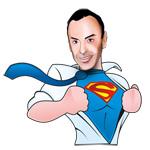
Take a lesson from the girls – long, clean, simple, bare bones, and attractive will always get a better response.
What’s up gang – it’s been a bit longer than I’d like between articles here, but if I’m MIA, you’d better believe that I’m hustling hard behind the scenes. Hope your fitness business is growing and you’re in heavy grind mode as well.
Right now I’ve got something cool that you might like. I recently turned in my monthly column for PFP Magazine, and like I’ve mentioned before, I kept it on the Vanilla side.
The rest of the fitness business isn’t really ready for the type of stuff we talk about here, and especially in my programs.
Actually the article I sent over was a variation on an old article I had here almost two years ago. Back then this info was pretty groundbreaking, but by now, everything I shared is pretty much common knowledge to you if you’ve been a reader of this site for any amount of time.
Sadly, for the rest of the industry, most of my article I’m sure will be earth shattering. That’s fine as long as it gets them moving in the right direction.
What I’m going to do right now is break down for you everything I put into that article. This will be kind of your inside look into what I was talking about, and make the whole thing more cutting edge. Enjoy.
************************************************
 How to Avoid an Unsightly Website (not my title – I’d never have called it that)
How to Avoid an Unsightly Website (not my title – I’d never have called it that)
By Kaiser Serajuddin
Leonardo Da Vinci said “Simplicity is the ultimate sophistication.” While we may not always take life and career advice from Leonardo Da Vinci, that little bit of advice should be kept in mind when designing a website, especially for fitness professionals.
In case you’re not aware, Da Vinci is likely the greatest genius in the history of mankind, so take his statement to heart. The way most of us screw up, me especially, is by making things way too complicated. Whatever you want, whether it’s personal, financial, or social, chances are you’re doing TOO MUCH unnecessary stuff and over-complicating your process of getting it. That’s another reason why I always emphasize the importance of setting aside enough time to do absolutely nothing, so you can simply plan and think, which are two of the biggest time savers of all.
Your site is the supporting leg holding your training practice up, but it still seems most trainers are clueless when it comes to creating their sites. They’re throwing all of their time and money into them and still getting horrible results. That’s really a shame, because having a well put together website can help immeasurably in the process of getting and keeping a “float” of high-paying clients.
Your site can be the biggest communication, education, positioning, and marketing tool in your arsenal. It has a lot of purposes and a lot of importance. Treat it like that.

Not everything that works to sell GUCCI will work for your fit-biz.
To help solve this problem, I’m going to give you as definitive a guide as possible to develop an effective website. The first thing to remember is to keep it simple. You can’t take your cues from Madison Avenue (the big-money marketing companies) or from entertainment promotion sites. You don’t need to pretend to be a billion dollar, big-shot training business to get clients. There’s a more proven field of advertising to take your cues from, and that’s direct-mail marketing. The direct marketing people have actually tested what formats and messages work best. They’ve done the work for you — just follow directions and you’ll get results.
Often times, what works in direct marketing flies in the face of “Madison Avenue” type advertising. But if you are very perceptive, you will find much major advertising today using direct marketing tactics. This has started very recently, in about the past 6 months, but if you’re sharp you’ll notice it. Look out for more testimonials, customer case studies, calls to action, expiration dates, risk-reversal offers, and other tools traditionally in direct marketing, now being used by major companies. They are finally getting a little hip to it. But for your small biz, I’d recommend using direct marketing tactics exclusively.
The info I’m going to share with you comes from the world of direct marketing. That means its validity has been tested in split testing response rates against multiple variables. If until now the only advertising you’ve studied has been in magazines, billboards and television, you’ll probably fight me tooth and nail on a lot of what I’ve written. I just ask that you chew on it and look into it yourself. It’ll get you on your way to saving time and money and boosting the effectiveness of everything you do.

A small biz pulling out all the guns can beat a big biz any day of the week.
Here are the most common website mistakes:
1. Too Much Flash A prospect looking at your site, either because of a web search or a piece of off-line advertising you put out, is in seeking mode. They don’t want to wait for your page to load or have their time wasted by flashy graphics and music. These flashy sites have been proven to perform worse than clear, simple sites. Even if you are extremely good looking and have unbelievably ripped abs and have photo-shoot pictures of yourself everywhere, you’ll still lose to someone that obeys the rules of providing solid information that benefits the client.
Don’t you hate it when you land on a site, looking for some info, and you have to wait for it to load, it has cheesy music, or it has no info to speak of? Always analyze your site and keep your eye out for things that might be distracting your visitor, and making it harder for them to be led to a sale.
2. Ugly As kind of a side note to point one, you don’t want to be too flashy, but your site can’t be ugly either. Everything on there has to lead to a sale in some way. I had this same conversation with a student yesterday. He had videos on his site, which is the right thing to do, but some were ugly. I told him to leave them out. Poor quality? Clumsy demonstration? Leave it off!
Again, ugly or blatantly screwed up parts of your site will hurt you. Even though we’re not trying to be flashy, still keep it clean. Like I mentioned, if you think it’s possibly detracting from a sale, get rid of it.
3. Over Budget As a trainer, you only need a few clients to get fully established and highly profitable. Once you’re there, you can start planning world domination, but get there first! To get to that level, you don’t need to spend a fortune. Never spend more on advertising than the advertising will yield. Your entire site should cost you only a few hundred bucks — that’s design and all tech work included. If people are talking into the thousands for design or set-up work, take it as an opportunity to get in some cardio and start running away!
You can do miracles with WordPress these days, and WordPress is free. Just have it installed with all of the latest plug-ins, get a nice header made for it, and put it on the web, and start to build from there. Putting in about 15 minutes a day on your site (and giving orders to your outsourced web programmer) will have you a world class site in just a few months (my licensing customers have been able to save a ton by getting my help with this, but there’s no reason why you can’t do the same on your own – it will just take you a little more time.)

4. Too Much Time Your site also should not take you too much time to get started. The main time will come in writing and fine-tuning the text, especially if you don’t like to write. But your first job is to get it done and get it on the web. Don’t wait until it’s perfect to put your site up; you can’t improve something that doesn’t even exist yet. Just get something up that you’re more or less happy with, and tweak it every day based on the new things you learn and other sites you see that you like.
See above.
5. Too Much “Me,” Not Enough Info Another mistake we get from Madison Avenue is to talk only about us — too many pictures of you, videos of you talking, and info about your “company.” You need to focus on the benefits to your client. Think about what your target group is looking for, and let them know you have the answer.
Always speak in terms of customer benefits. Talk in their language, in very simple terms, and with their needs in mind. Only then, after you have proven that you understand them, can you begin to talk about YOU.
Don’t be afraid to give away pages and pages of valuable information on your website. You may ask yourself, “Who’s going to read all that?” Well, someone that’s about to shell out close to 100 bucks an hour and spend an extended amount of time with a complete stranger (especially if you’re coming to their home) will want as much information as possible. They want to know that you know your business. I’ve been shocked and amazed by how many new clients coming to me have been able to quote some obscure piece of information hidden on a deep page in my site — but it showed me the time I took to write it was worth it.
The more content the better. As long as it’s interesting, you cannot have enough. But be sure to keep your call to action prominent throughout, for whenever the customer is done browsing and ready to buy.
6. The Contact Info If people can’t quickly see how to contact you, they’ll give up after only a few seconds. Have your phone number visible very prominently at the top of every page of your site. Also include your email address and location.
Speaking of location, try to mention your primary area as much as possible on your site. This alone, without any complicated SEO, has gotten my site as the top Google listing in a town of 2.3 million people, keeps me there, and has my phone ringing nearly every day because of it.
Have your contact info at the top and bottom of every page of your site, and possibly a few times in the body. And be sure to mention your area in all of your title tags, and in all of your blog posts. This is important.
7. Make an Offer (But Don’t Quote Prices) This was a topic that was debated by trainers for year. I try to get my info from what’s been proven to work, not my hunches or even my common sense. And it’s been proven that stating the full-price up front will kill your response rates. You preferably want to wait til you can tell this person face-to-face, at a time and place when you are both relaxed, comfortable, and in control, and after they have had a chance to train with you and bond with you. At this point, you can charge almost anything you want.
Instead of giving out your full prices, give them an exciting reason to contact you — “ an “irresistible offer.” Then take it from there.
If you DO want to quote your price, be sure it is only after you have built up a lot of value in your services through your web copy and testimonials.

8. The Crutch Like we’ve already talked about, your site is hugely important. However, some trainers think their site will do everything for them. It does a lot, but it’s only a part of the puzzle. You also have to make contacts, work on your face to face selling, and look for referrals.
One of the main reasons I recommend taking the simple route with your site is because it’s only part of the puzzle. You have a lot to focus on, so make sure your site is something that’s fun and easy for you to update and work on. Hire an outsourced programmer to update it for you, and let them know whatever you need done.
I have to say, I was a VERY late adopter of the web, and it hampered me most of my training career. Once I got this handled, my career went on autopilot. I could charge higher rates than anyone and just wait for who wanted to pay them to come to me. Keep tweaking your overall approach each and every day until you get to the same place.
You may have noticed I didn’t mention TESTIMONIALS anywhere here. That’s because they’re so important, I’m planning on writing a full article about them soon. The right testimonials can be used to avoid every problem listed above.
Testimonials truly are king. Testimonials, before and after pictures, case studies, customer letters, demonstrations, pictures of customers – you literally cannot have enough.
But the principles still hold — just keep it simple and be yourself; I don’t think that will ever stop working.
That “be yourself” part is huge as well. Communicate a vibe and personality as part of your business. You’re trying to differentiate yourself from the nameless, faceless business out there, so don’t hesitate to express yourself.
************************************************
Hope that gave you a bit more insight into what I was talking about, and gave you a few take home lessons. When I nailed it with my site was when my life changed and my fit-biz transformed. Looking forward to hearing that you’re getting the same results.

I remember when you first posted this. Yeah you’re right, it’s a little outdated but most trainers still aren’t doing this shit (including me) so good reminder.
Very good post Kaiser. I am now planning my website and this was very helpful. I have also purchased your brandnig services and will order taht as well. Thank you for your help.
Hi Kaiser!
Great post as usual. Things have been going great for me so I haven’t had the chance to get you my licensing instructions yet. I have an assistant and it’s working out well. And the new year was very good to me. Honestly, I don’t think I could handle any new clients! (I guess that’s a good problem to have.) I’m glad your license will take care of all this. I know it’s important and I woudn’t want to have a site without it. Great info and keep it coming – I’m hungry :-) thanks!
Nice article Kaiser, few tips in there worth looking into for new comers like myself. It’s very true that everything is an evolution and you just have to keep tweaking everything as you go
I lately have become really effeicent at SEO and I can co-sign when I say using your website the right way can do wonders for your career.
This is a classic Kasier, ha!
This info is still as true as ever, and no one is still doing it yet – great post and great info as usual Kaiser.
Thanks, Kaiser, for such useful information!!! I will change my website asap!!!
You say it may this may be a bit dated, but it’s unbelievable to me how much I still see flash intros to websites. Anytime I see that I close it immediately. The reason being is it takes forever to load, and I could care less about what they are showing.
I want the info. I want to know what it’s going to do for me, and how i can get it without a hassle.
Like you said, keep it simple. WordPress works wonders, and I personally like to see a ton of testimonials.
Keep rockin’ it Kaiser!
Some things need repeating. This falls into that category. The simple gifts you’ve written can mean a world of difference in the response one will get from their site. Done properly, you won’t even have to worry about “selling yourself” when you meet the client face to face. Simply continue to prove what you have to offer and meet that person’s expectation, and you should have yourself a new client. The more information and answering the questions you know they’re thinking while looking at your site, the easier it will be for you later when it comes to sealing the deal.
Kaiser my man good post – every trainer needs to read this.
I should let m y hubby read this to him, this would be of use to him since he is a trainer. Thank for the tips you shared to us.